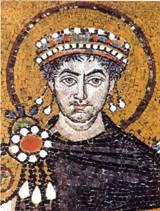Byzantine Empire under Justinian
THE BYZANTINE EMPIRE UNDER JUSTINIAN
Objectives:
 Students should know the name of the Byzantine Empire and its capital, Constantinople.
Students should know the name of the Byzantine Empire and its capital, Constantinople.- Students should be able to name Justinian as a wise Emperor and list 2-3 of his accomplishments.
Possible Lesson Plan:
- Open with prayer.
- Tell the story of the Byzantine Emperor and Justinian:
About 50 years after the fall of Rome, Justinian became emperor in the East. In this day, Constantinople was the greatest city in the world. The waters around the city were filled with boats; it had high walls to protect it from enemies. People came from all over the world to see the beautiful city and study in its many famous schools and worship in its churches. Justinian saw his city as the Second Rome, greater and finer than Rome ever was.
Justinian also began to collect all the laws of his land. Until this time, each city and state had its own rules and judges. Justinian sent wise lawyers throughout the land and gathered all these laws. They chose the best from each city and wrote a law that would be true throughout the land, the Code of Justinian.
Justinian wanted to take back the lands of the west that had been lost to the barbarians. He first sent his mighty army against the Vandals in North Africa. He took back northern Africa and went from there to Italy and southern Spain. His empire went around the Mediterranean, although he never retook France or England.
Justinian also had architects throughout his empire build beautiful churches. The greatest of these was Hagia Sophia, the Church of the Holy Wisdom, in Constantinople. This magnificent church is topped with a huge dome. Artists painted beautiful icons and worked mosaics of tiny pieces of stone and glass. A mosaic could cover the entire wall of a church or monastery. Goldsmiths made beautiful jewelry set with precious stones. The Byzantine Empire became the art and cultural capital of the world.
Add Justinian the Great to your timeline.
- Feed the Elephant True/False Questions:
True False
Justinian was Emperor of Constantinople. Justinian was Emperor in Rome.
The Code of Justinian is made of laws. The Code of Justinian is used by spies.
Justinian took back Italy and north Africa. Bishop Leo took back Italy and Africa.
Hagia Sophia means Holy Wisdom. Hagia Sophia is a girl’s name.
Hagia Sophia is a church. Hagia Sophia is a piece of furniture.
- Make a class model of Hagia Sophia: Take a rectangular box and put a dome on top with a salad bowl. Add two towers of paper towel rolls. Now the fun begins: Take play doh and cover the dome with gold, the box with white or blue, the towers can be red. Give the towers a top. Point out the architectural features – dome, nave. You can even cover the outside with a paper or wood chip mosaic pushed into the play doh. Sprinkle gold glitter on the dome. Let it dry for next Sunday. The students can each shape a small one of play doh to take home.
Too messy or involved? Then make a pop-up card of the beautiful Hagia Sophia. Use the pattern on, either one in color or one for the children to color. Print on cardstock. Fold on middle blue line. Cut two slits thru both thicknesses on red lines. Now fold the middle blue line backwards and the two other blue lines so Hagia Sophia will stand up when the card is opened. For stability, glue entire card except pop-op on a piece of construction paper folded in the middle.
- Close with prayer: Lord, give me a love of the beauty of Your Church as Justinian had.